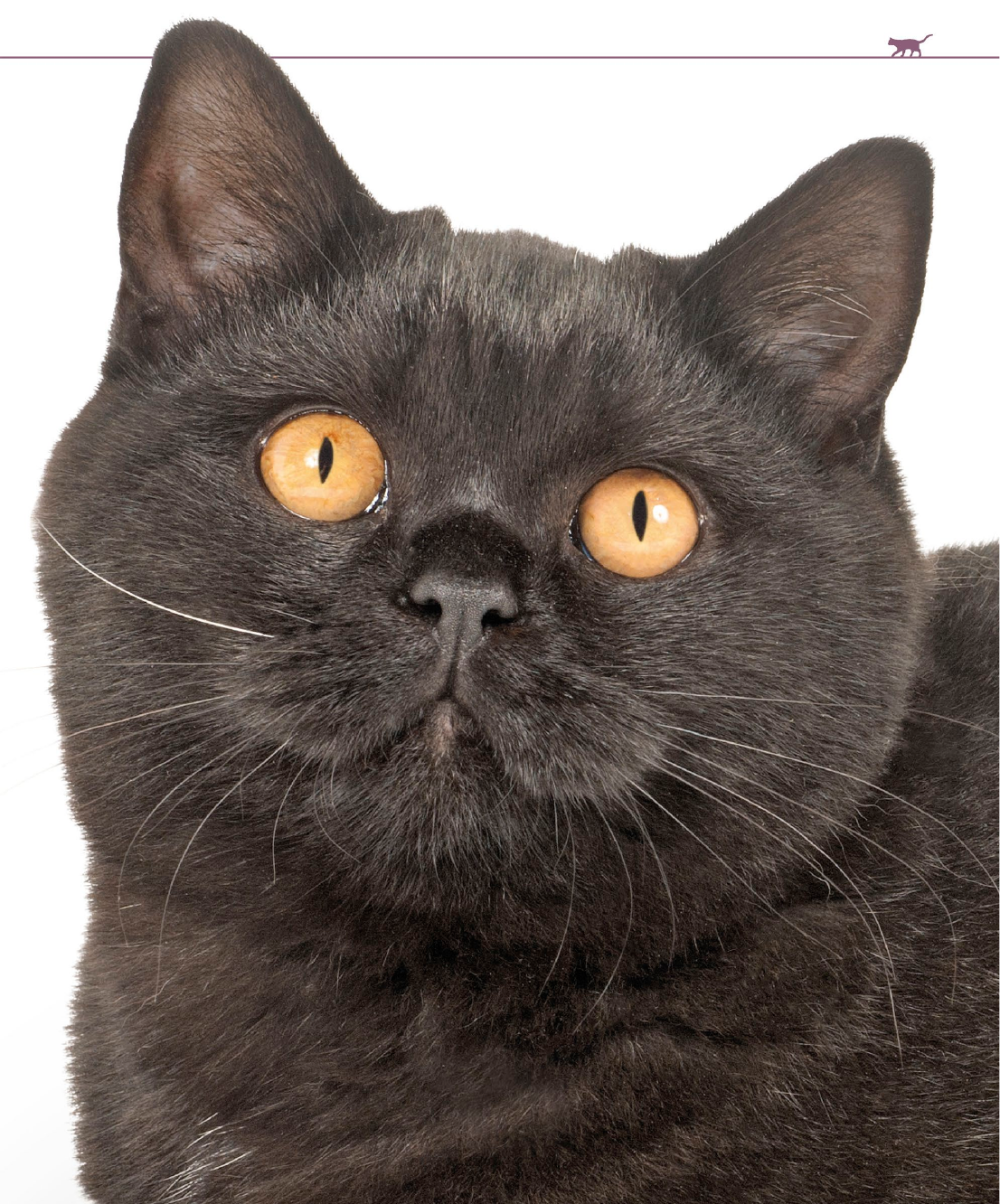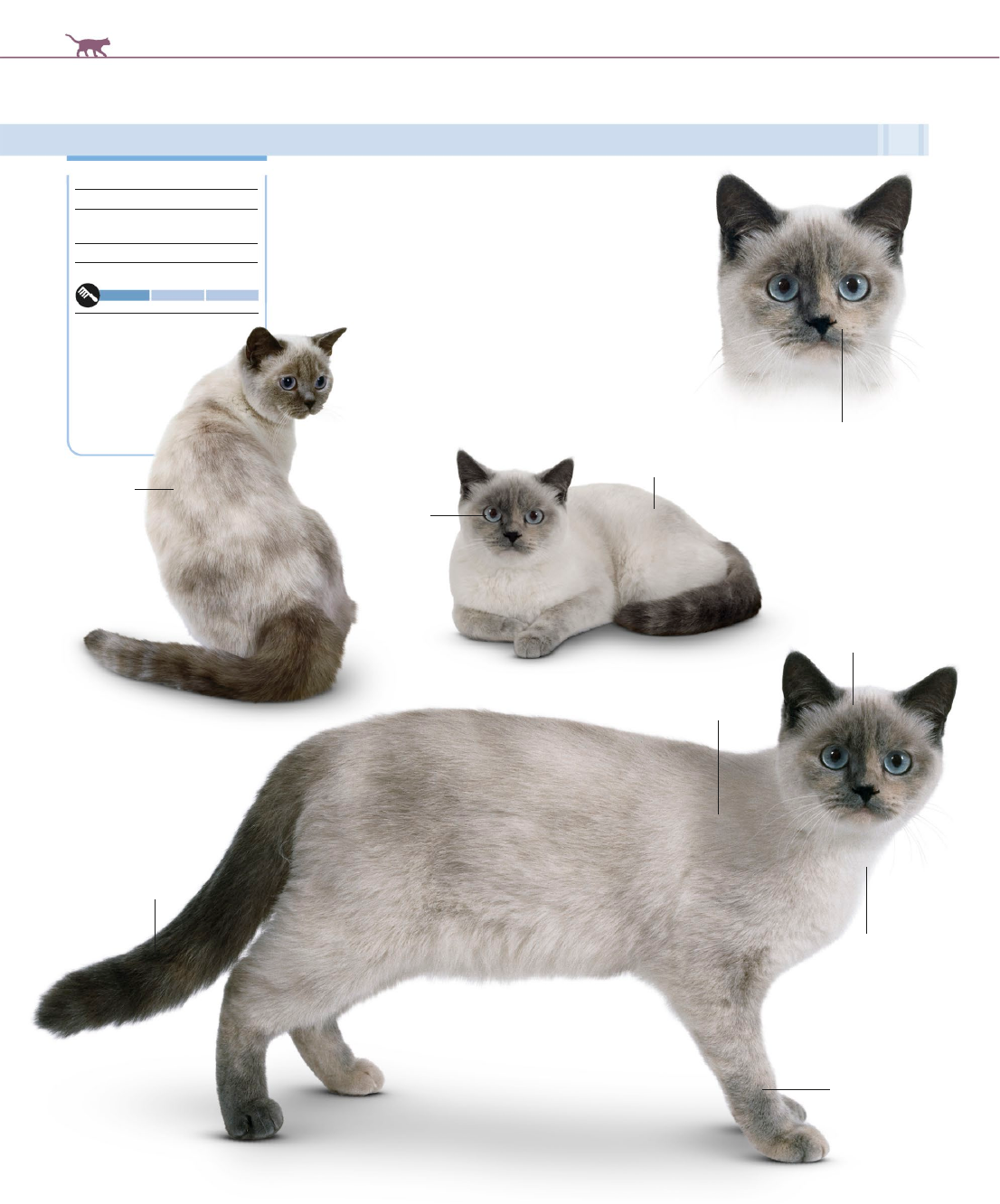
PLUSH FUR
The Russian Blue’s coat, with its rich pile
and silvery sheen, is a distinguishing
feature of the breed. This kitten is still
at the cute stage, but as an adult he
will combine grace with dignity.
US_066-067_RussianBlue-SPS.indd 67US_066-067_RussianBlue-SPS.indd 67 11/02/21 7:04 PM11/02/21 7:04 PM

CATALOG OF BREEDS
68
A CAT THAT COMBINES GOOD LOOKS WITH AN EASYGOING TEMPERAMENT
BRITISH SHORTHAIR—SOLID
Originally developed from the best
examples of ordinary British domestic
cats, the British Shorthair was one of
the first pedigree cats to appear in shows
during the late 19th century. In the following
decades, the Shorthair was all but eclipsed
by longhaired cats, particularly the Persian,
but survived by a narrow margin to enjoy a
revival from the mid-20th century onward.
A descendant of cats that worked for their
living, keeping down vermin on farms and
homesteads, the British Shorthair is now
something of a blueprint for the perfect
fireside cat. The breed is highly popular in
Europe and is steadily gaining a following
in the US, where it is less well-known.
Many decades of careful selection
have produced a well-proportioned cat
of superb quality. Powerfully built, the
British Shorthair has a medium to large,
tightly knit body carried on sturdy legs.
The massive, round head; broad cheeks; and
large, open eyes are characteristic features
of the breed. The British Shorthair has a
short, dense coat that comes in a variety of
colors and has a deep pile and firm texture.
In temperament, this cat is as calm
and friendly as its chubby-cheeked, placid
expression appears to suggest. It can be
kept equally well as a town or country cat.
Strong, but not athletic or hyperactive, a
British Shorthair prefers to keep its paws
on the ground and is perfectly happy to stay
indoors and commandeer the sofa. However,
it also enjoys time outside and readily uses
the hunting skills that made its ancestors
such an asset in the past.
Quietly affectionate, the Shorthair
likes to stay near its owner. Although alert
to what is going on in the household, this
cat it is not overdemanding of attention.
British Shorthairs generally have robust
health and can be long-lived. They are easy
to care for, because the thick coat does not
mat or tangle and regular combing is all that
is required to keep it in good condition.
Place of origin UK
Date of origin 1800s
Breed registries CFA, FIFe,
GCCF, TICA
Weight range 9–18 lb (4–8 kg)
Grooming
Colors and patterns
All solid colors.
Tail tapers
slightly
Massive
head with
full cheeks
Large, round
golden eyes
Short,
strong
neck
Small ears set
wide apart
Short, dense
black coat
with no white
markings
Medium-short,
strongly
boned legs
Large, powerful
body
Firm,
round paws
US_068-069_British_Shorthair_Self_A-SPREAD_NO_BOX.indd 68US_068-069_British_Shorthair_Self_A-SPREAD_NO_BOX.indd 68 11/02/21 7:04 PM11/02/21 7:04 PM

69
SHORTHAIRS
US_068-069_British_Shorthair_Self_A-SPREAD_NO_BOX.indd 69US_068-069_British_Shorthair_Self_A-SPREAD_NO_BOX.indd 69 11/02/21 7:04 PM11/02/21 7:04 PM

CATALOG OF BREEDS
70
SIAMESE-TYPE COLORS ADD A NEW LOOK TO THIS TRADITIONAL BREED
BRITISH SHORTHAIR—COLORPOINTED
The most recent of the British Shorthair variations,
the Colorpoint was recognized only in 1991. This unusual
cat is the result of experimental crossbreeding to produce
a British Shorthair with the pointed coat pattern of the
Siamese. Various attractive colors have been developed
and, like the Siamese, all types have blue eyes, although the
stocky build and round head typical of the Shorthair remain
unchanged. Because of the similarities in name,
the British Shorthair Colorpoint is sometimes
confused with an Oriental-type American breed
called the Colorpoint Shorthair (p.58).
Place of origin UK
Date of origin 1800s
Breed registries FIFe, GCCF,
TICA
Weight range 9–18 lb (4–8 kg)
Grooming
Colors and patterns
Various point colors,
including blue-cream,
seal, red, chocolate,
and lilac; also
with lynx and
tortie patterns.
Blue-cream
tortie mask
Tortie pattern
more evident
on tail
Typically full,
rounded face
Pale
ground
color with
blue-cream
highlights
Short neck
Powerful
shoulders
Blue points
broken with
cream markings
Chunky body
Round
blue eyes
US_070_071_British_SH_Colourpoint_Brtish_SH_Bi_Colour.indd 70US_070_071_British_SH_Colourpoint_Brtish_SH_Bi_Colour.indd 70 11/02/21 7:04 PM11/02/21 7:04 PM

71
SHORTHAIRS
THIS HANDSOME CAT IS BOLDLY MARKED WITH COLOR PATCHES
BRITISH SHORTHAIR—BICOLOR
Black and white British Shorthairs were much valued in
the 19th century, when this breed had its beginnings, but
they were never common. The Bicolor as it is today, which
comes in several combinations of white and another color,
was not fully developed until the 1960s. At that time,
almost impossibly high breeding standards required the
color patches to be distributed over head and body with
complete symmetry. The rules have since been relaxed,
but the best Bicolors still have
strikingly even markings.
Place of origin UK
Date of origin 1800s
Breed registries CFA, FIFe,
GCCF, TICA
Weight range 9–18 lb (4–8 kg)
Grooming
Colors and patterns
Black and white, blue and
white, red and white, and
cream and white.
Straight,
well-boned
forelegs
Broad,
rounded
cheeks
White on legs
and underside
Symmetrically
distributed
blue markings
Large, rounded
golden eyes
Solid-color
tail
Fluffy coat
Large,
powerful body
White blaze on face
Pink nose
leather
Kittens
Rounded
paws
US_070_071_British_SH_Colourpoint_Brtish_SH_Bi_Colour.indd 71US_070_071_British_SH_Colourpoint_Brtish_SH_Bi_Colour.indd 71 11/02/21 7:04 PM11/02/21 7:04 PM
..................Content has been hidden....................
You can't read the all page of ebook, please click here login for view all page.
